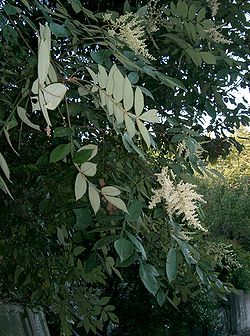Rhus chinensis
Species of tree From Wikipedia, the free encyclopedia
Rhus chinensis, the Chinese sumac[2] or nutgall tree, is a deciduous shrub or small tree in the genus Rhus. Growing to 6 m (20 ft) tall, it has downy shoots and leaves comprising several leaflets. These turn red in autumn before falling.[3]
| Chinese sumac | |
|---|---|
 | |
| Scientific classification | |
| Kingdom: | Plantae |
| Clade: | Tracheophytes |
| Clade: | Angiosperms |
| Clade: | Eudicots |
| Clade: | Rosids |
| Order: | Sapindales |
| Family: | Anacardiaceae |
| Genus: | Rhus |
| Species: | R. chinensis |
| Binomial name | |
| Rhus chinensis | |
| Synonyms | |
| |
The plant is common in East and South Asia,[4] and is cultivated as an ornamental in temperate climates.
Galls produced on the species that are called Chinese gall (Galla chinensis), are a source of gallotannins,[5][6] molecules of hydrolyzable tannins. Infestation of the tree by Chinese sumac aphids (Melaphis chinensis Bell) may lead to production of a gall that is valued as a commercial product in China.
Chinese galls are used in traditional Chinese medicine for coughs, diarrhea, night sweats, dysentery, and intestinal and uterine bleeding.[7] Some research has suggested that chemical compounds found in Rhus chinensis possess in vitro antiviral, antibacterial, anticancer, hepatoprotective, antidiarrheal, and antioxidant activities.[4] The aqueous extracts of the gall also inhibit alpha-glucosidase activity in vitro.[8]
- Foliage
- Flowers
- Fruits
- Sapling
References
External links
Wikiwand - on
Seamless Wikipedia browsing. On steroids.





